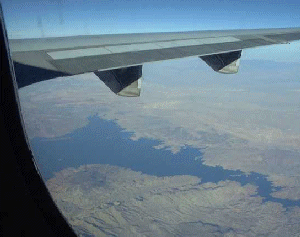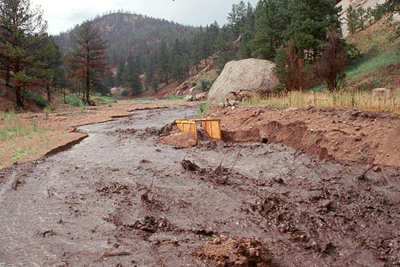Communities in Colorado may soon have advance warning of dangerous flash floods.
Click on image for full size
Courtesy of the U.S. Geological Survey
Forecasting Flash Floods in Colorado's Mountains
News story originally written on July 22, 2008
Dangerous flash floods have killed hundreds of people and caused lots of damage to buildings and roads in the Front Range of Colorado’s Rocky Mountains. The area gets summer flash floods because of its steep valleys and big summer thunderstorms.
Soon, people living near creeks and rivers in this area will be warned of dangerous flash floods. The warming will come from a new tool being tested by the National Center for Atmospheric Research (NCAR).
It’s hard to give people warning that a flash flood is going to happen because they happen so quickly. Forecasters can tell when stormy weather might cause a flood. Their radars can detect heavy rain and can tell when a storm has stopped moving, releasing lots of water in one area. But flash floods don’t happen every time it rains. They also depend on the soil, the shape of the land and the shape of the river or stream.
The new tool combines weather information with information about the water flowing in streams and the shape of the land. It can give people at least 30 minutes warning before flood waters start rising and possibly as much as an hour or two.
Right now scientists are just testing the tool, but they hope that someday it can be used to keep people safe from flash floods.
Last modified September 5, 2008 by Lisa Gardiner.
You might also be interested in:

Thunderstorms are one of the most exciting and dangerous types of weather. Over 40,000 thunderstorms happen around the world each day. Thunderstorms form when very warm, moist air rises into cold air.
...more
Rivers are very important to Earth because they are major forces that shape the landscape. Also, they provide transportation and water for drinking, washing and farming. Rivers can flow on land or underground
...more
Scientists have learned that Mount Hood, Oregon's tallest mountain, has erupted in the past due to the mixing of two different types of magma. Adam Kent, a geologist at Oregon State University, says this
...more
The Earth's mantle is a rocky, solid shell that is between the Earth's crust and the outer core. The mantle is made up of many different reservoirs that have different chemical compositions. Scientists
...more
Some faults look strong and like they wouldn’t cause an earthquake. But it turns out that they can slip and slide like weak faults causing earthquakes. Scientists have been looking at one of these faults
...more
The sun goes through cycles that last approximately 11 years. These solar cycle include phases with more magnetic activity, sunspots, and solar flares. They also include phases with less activity. The
...more
Studying tree rings doesn't only tell us the age of that tree. Tree rings also show what climate was like while the tree was alive. This means that tree rings can tell us about climates of the past. Two
...more















